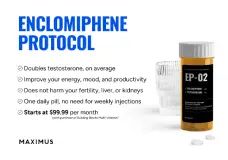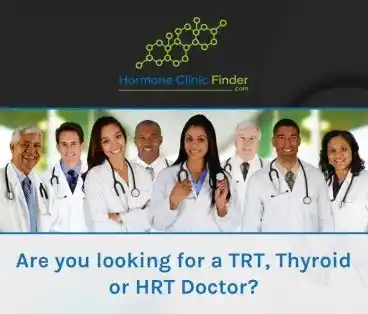madman
Super Moderator
Benefits and Risks of Testosterone Treatment in Men with Age-Related Decline in Testosterone
Marcelo Rodrigues dos Santos, and Shalender Bhasin
Abstract
The substantial increase in life expectancy of men has focused growing attention on quality-of-life issues associated with reproductive aging. Serum total and free testosterone levels in men, after reaching a peak in the second and third decade of life, decline gradually with advancing age. The trajectory of age-related decline is affected by comorbid conditions, adiposity, medications, and genetic factors. Testosterone treatment of older men with low testosterone levels improves overall sexual activity, sexual desire, and erectile function; improves areal and volumetric bone density, as well as estimated bone strength in the spine and the hip; corrects unexplained anemia of aging; increases skeletal muscle mass, strength and power, self-reported mobility, and some measures of physical function; and modestly improves depressive symptoms. The long-term effects of testosterone on major cardiovascular events and prostate cancer risk remain unclear. The Endocrine Society recommends against testosterone therapy of all older men with low testosterone levels but suggests consideration of treatment on an individualized basis in men who have consistently low testosterone levels and symptoms or conditions suggestive of testosterone deficiency.
INTRODUCTION
Hypogonadism is a syndrome that results from reduced production of testosterone (androgen deficiency) and spermatozoa by the testes due to disruption of one or more levels of the hypothalamic-pituitary-gonadal (HPG) axis (1). Testosterone is approved by the US Food and Drug Administration (FDA) for the treatment of classical hypogonadism due to known diseases of the testis, pituitary, and hypothalamus (2). Prior to the advent of radio-immunoassays for the measurement of circulating testosterone levels, the diagnosis of hypogonadism was usually established on the basis of clinical findings, such as delayed or absent pubertal development, absence of secondary sex characteristics, gynecomastia, and small testes. In men with severe hypogonadism, testosterone treatment was associated with clinically apparent benefits, including a marked improvement in sexual function, development or restoration of secondary sex characteristics, and clinically apparent changes in body habitus, with a low frequency of adverse events. Thus, the benefit-to-risk ratio in these patients with severe testosterone deficiency was favorable.
During the past 20 years, testosterone prescription sales in the United States and in many other countries have grown substantially. Today, most testosterone prescriptions in the United States are written for middle-aged and older men, most of whom have low normal or mildly low testosterone levels (2). Neither the clinical benefits nor the long-term safety of testosterone treatment has been fully established in middle-aged and older men with age-related decline in testosterone levels, and testosterone treatment is not currently approved by the FDA for this indication.
EPIDEMIOLOGY OF AGE-RELATED DECLINE IN TESTOSTERONE LEVELS
PATHOPHYSIOLOGY OF AGE-RELATED DECLINE IN TESTOSTERONE LEVELS
PHYSIOLOGIC AND CLINICAL SIGNIFICANCE OF AGE-RELATED DECLINE IN TESTOSTERONE LEVELS
MENDELIAN RANDOMIZATION STUDIES
POTENTIAL BENEFITS OF TESTOSTERONE TREATMENT IN OLDER MEN: FINDINGS OF RANDOMIZED TRIALS
POTENTIAL ADVERSE EFFECTS OF TESTOSTERONE TREATMENT IN OLDER MEN
TESTOSTERONE TREATMENT AND THE RISK OF PROSTATE CANCER AND LOWER URINARY TRACT SYMPTOMS
TESTOSTERONE TREATMENT AND THE RISK OF CARDIOVASCULAR EVENTS
CONTRAINDICATIONS FOR TESTOSTERONE TREATMENT
MONITORING TESTOSTERONE REPLACEMENT THERAPY IN OLDER MEN
Management of PSA Elevations
Management of Hematocrit Elevations
A PATIENT-CENTERED APPROACH TO TREATMENT DECISION IN OLDER MEN WITH TESTOSTERONE DEFICIENCY
Because of the lack of evidence of long-term safety and limited evidence of long-term efficacy of testosterone therapy in older men with symptomatic androgen deficiency, there still remains some controversy about the indications for treatment in these patients. The expert panel of the Endocrine Society recommended against testosterone therapy for all men 65 years or older with low testosterone levels (1). Instead, the Endocrine Society’s guideline suggests that testosterone therapy should be offered on an individualized basis after explicit discussion of the potential risks and benefits “...in men >65 years who have symptoms or conditions suggestive of testosterone deficiency (such as low libido or unexplained anemia) and consistently and unequivocally low morning testosterone” (1, p. 1716)
The decision of whether to offer testosterone treatment to older men with low testosterone levels should be guided by several considerations. First, evaluate whether the patient has clear evidence of testosterone deficiency. The diagnosis of testosterone deficiency should be made on the basis of two or more early-morning, fasting testosterone levels below the lower limit of normal for healthy young men, plus the presence of symptoms. Consider the imprecision and inaccuracies of the diagnostic assays for total and free testosterone levels, especially in men whose testosterone levels are close to the lower limit of the normal range. Use ancillary data such as testicular volume, secondary sex characteristics, and LH and follicle-stimulating hormone levels, which can reduce the risk of misclassification.
Second, weigh the burden of symptoms/conditions against the known benefits and the uncertainty of long-term harm, recognizing that sexual symptoms are the most robustly associated with testosterone deficiency and are the most consistently improved by testosterone treatment.
Third, ascertain whether the patient has any conditions, such as prostate cancer, severe lower urinary tract symptoms, erythrocytosis, or deep venous thrombosis, that might increase the risk of harm. Older men considering testosterone supplementation should undergo baseline evaluation of risk factors for prostate cancer. Prostate cancer screening has some risks; therefore, the initiation of prostate screening and monitoring should be a shared decision. Men with a history of prostate cancer should not be given androgen supplementation, and those with palpable abnormalities of the prostate or PSA levels greater than 3 ng/ml should undergo urological evaluation (1).
Fourth, share the burden of decision making with the patient. Physicians should recognize that there is considerable disagreement among experts on this issue due to incomplete evidence Nonspecific age-related symptoms and low testosterone concentrations often coexist in older men without a clear causal link. The patient’s burden of symptoms, preferences, and risk tolerance should be weighed against the uncertainty of benefits and risks, the burden and risks of monitoring, and the cost. Finally, a shared decision to initiate testosterone treatment should be accompanied by a standardized monitoring plan.
Marcelo Rodrigues dos Santos, and Shalender Bhasin
Abstract
The substantial increase in life expectancy of men has focused growing attention on quality-of-life issues associated with reproductive aging. Serum total and free testosterone levels in men, after reaching a peak in the second and third decade of life, decline gradually with advancing age. The trajectory of age-related decline is affected by comorbid conditions, adiposity, medications, and genetic factors. Testosterone treatment of older men with low testosterone levels improves overall sexual activity, sexual desire, and erectile function; improves areal and volumetric bone density, as well as estimated bone strength in the spine and the hip; corrects unexplained anemia of aging; increases skeletal muscle mass, strength and power, self-reported mobility, and some measures of physical function; and modestly improves depressive symptoms. The long-term effects of testosterone on major cardiovascular events and prostate cancer risk remain unclear. The Endocrine Society recommends against testosterone therapy of all older men with low testosterone levels but suggests consideration of treatment on an individualized basis in men who have consistently low testosterone levels and symptoms or conditions suggestive of testosterone deficiency.
INTRODUCTION
Hypogonadism is a syndrome that results from reduced production of testosterone (androgen deficiency) and spermatozoa by the testes due to disruption of one or more levels of the hypothalamic-pituitary-gonadal (HPG) axis (1). Testosterone is approved by the US Food and Drug Administration (FDA) for the treatment of classical hypogonadism due to known diseases of the testis, pituitary, and hypothalamus (2). Prior to the advent of radio-immunoassays for the measurement of circulating testosterone levels, the diagnosis of hypogonadism was usually established on the basis of clinical findings, such as delayed or absent pubertal development, absence of secondary sex characteristics, gynecomastia, and small testes. In men with severe hypogonadism, testosterone treatment was associated with clinically apparent benefits, including a marked improvement in sexual function, development or restoration of secondary sex characteristics, and clinically apparent changes in body habitus, with a low frequency of adverse events. Thus, the benefit-to-risk ratio in these patients with severe testosterone deficiency was favorable.
During the past 20 years, testosterone prescription sales in the United States and in many other countries have grown substantially. Today, most testosterone prescriptions in the United States are written for middle-aged and older men, most of whom have low normal or mildly low testosterone levels (2). Neither the clinical benefits nor the long-term safety of testosterone treatment has been fully established in middle-aged and older men with age-related decline in testosterone levels, and testosterone treatment is not currently approved by the FDA for this indication.
EPIDEMIOLOGY OF AGE-RELATED DECLINE IN TESTOSTERONE LEVELS
PATHOPHYSIOLOGY OF AGE-RELATED DECLINE IN TESTOSTERONE LEVELS
PHYSIOLOGIC AND CLINICAL SIGNIFICANCE OF AGE-RELATED DECLINE IN TESTOSTERONE LEVELS
MENDELIAN RANDOMIZATION STUDIES
POTENTIAL BENEFITS OF TESTOSTERONE TREATMENT IN OLDER MEN: FINDINGS OF RANDOMIZED TRIALS
POTENTIAL ADVERSE EFFECTS OF TESTOSTERONE TREATMENT IN OLDER MEN
TESTOSTERONE TREATMENT AND THE RISK OF PROSTATE CANCER AND LOWER URINARY TRACT SYMPTOMS
TESTOSTERONE TREATMENT AND THE RISK OF CARDIOVASCULAR EVENTS
CONTRAINDICATIONS FOR TESTOSTERONE TREATMENT
MONITORING TESTOSTERONE REPLACEMENT THERAPY IN OLDER MEN
Management of PSA Elevations
Management of Hematocrit Elevations
A PATIENT-CENTERED APPROACH TO TREATMENT DECISION IN OLDER MEN WITH TESTOSTERONE DEFICIENCY
Because of the lack of evidence of long-term safety and limited evidence of long-term efficacy of testosterone therapy in older men with symptomatic androgen deficiency, there still remains some controversy about the indications for treatment in these patients. The expert panel of the Endocrine Society recommended against testosterone therapy for all men 65 years or older with low testosterone levels (1). Instead, the Endocrine Society’s guideline suggests that testosterone therapy should be offered on an individualized basis after explicit discussion of the potential risks and benefits “...in men >65 years who have symptoms or conditions suggestive of testosterone deficiency (such as low libido or unexplained anemia) and consistently and unequivocally low morning testosterone” (1, p. 1716)
The decision of whether to offer testosterone treatment to older men with low testosterone levels should be guided by several considerations. First, evaluate whether the patient has clear evidence of testosterone deficiency. The diagnosis of testosterone deficiency should be made on the basis of two or more early-morning, fasting testosterone levels below the lower limit of normal for healthy young men, plus the presence of symptoms. Consider the imprecision and inaccuracies of the diagnostic assays for total and free testosterone levels, especially in men whose testosterone levels are close to the lower limit of the normal range. Use ancillary data such as testicular volume, secondary sex characteristics, and LH and follicle-stimulating hormone levels, which can reduce the risk of misclassification.
Second, weigh the burden of symptoms/conditions against the known benefits and the uncertainty of long-term harm, recognizing that sexual symptoms are the most robustly associated with testosterone deficiency and are the most consistently improved by testosterone treatment.
Third, ascertain whether the patient has any conditions, such as prostate cancer, severe lower urinary tract symptoms, erythrocytosis, or deep venous thrombosis, that might increase the risk of harm. Older men considering testosterone supplementation should undergo baseline evaluation of risk factors for prostate cancer. Prostate cancer screening has some risks; therefore, the initiation of prostate screening and monitoring should be a shared decision. Men with a history of prostate cancer should not be given androgen supplementation, and those with palpable abnormalities of the prostate or PSA levels greater than 3 ng/ml should undergo urological evaluation (1).
Fourth, share the burden of decision making with the patient. Physicians should recognize that there is considerable disagreement among experts on this issue due to incomplete evidence Nonspecific age-related symptoms and low testosterone concentrations often coexist in older men without a clear causal link. The patient’s burden of symptoms, preferences, and risk tolerance should be weighed against the uncertainty of benefits and risks, the burden and risks of monitoring, and the cost. Finally, a shared decision to initiate testosterone treatment should be accompanied by a standardized monitoring plan.
Attachments
Last edited:













